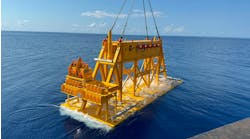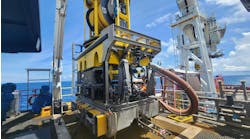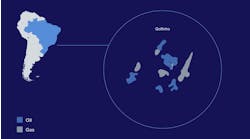Gde Pradnyana, BPMIGAS,
Jafar Korloo, Chevron
Developments of Indonesia’s oil and gas prospects in the deepwater areas of Makassar Strait have unique challenges for floating systems using dry tree units. Despite benign wind and wave conditions, the area is subjected to strong persistent currents. The combination of deepwater currents and large number of risers introduces unique design challenges.
The Makassar Strait is protected by the Philippine Islands in the north and the Indonesian Islands in the south. The wind and waves are quite benign ranging in the 0.5 m to 1.5 m wave height range with wind speeds of 10 to 20 kts for the normal operating conditions.
The current conditions in the Makassar Strait are of prime concern for their effect on the floating facilities as well as on the subsurface elements such as risers. The importance of current has resulted in long-term collection of current data at every potential installation site for at least one year.
A typical data set taken over a one-year period consists of 20,000 current profiles. One of the challenges facing the designer is the interpretation and reduction of the current data to a manageable data set and the application for overall loading and fatigue calculation due to vortex induced vibration (VIV).
Dry tree concepts
A dry tree development has the wellheads in air at deck level of the facility. The wells are drilled and serviced from the production platform either by a stand-alone facility or by tender-assisted drilling. The key requirement of a dry tree floating system is the ability to accommodate the risers and associated stroke arising primarily from heave, transitional motions of the floater, and tidal changes.
For dry trees, the motions of the floating facility relative to the risers need to be restricted. Risers must be tensioned through connections to the deck and/or by buoyancy cans. Therefore, only concepts with low motions (particularly heave and roll) are suitable for dry tree operations.
The dry tree concepts suitable for application in the Makassar Strait are TLP, spar, semi, dry tree barges, and a number of other low-heave-response type concepts. However, it is the TLP design for the West Seno development that has been used first in Indonesia’s Makassar Strait.
Comparative cost assessment
Careful consideration should be given to the maturity of the concept, transportation and installation issues, and the procurement issue when selecting a floating system concept.
An in-depth comparative analysis of the various dry tree floating systems was carried out for Indonesia deepwater application. The analysis showed that due to the low wave heights and the high persistent surface and deep currents, a spar design may not be the best solution. In addition, a spar was evaluated to have the highest hull costs and high installation costs in this application.
The dry barge concept having risers tensioned by means of buoyancy cans is quite mature and has been proposed for several West Africa deepwater projects. However, the riser tensioning system is complex and may require further specific site investigations.
Considering the low wave height nature of the area, the semi concept offers no major advantage over the dry tree barge concept and it suffers from the same riser system issues as the barge. The maturity of the dry tree semi concept is not at the same level as the dry tree barge.
TLPs, by design, move in surge and sway with wind, waves and currents, but resist heave, roll and pitch because of the fixed length of the tendons. A TLP uses a buoyant hull securely fastened to the seafloor by tensioned tubulars, or tendons. The buoyancy of the hull applies the tension to the tendons. TLPs have been developed and used since the early 1980s in a variety of shapes, configurations, and sizes.
The TLP concept with drilling tender assist proved attractive at West Seno for several reasons.
The key advantages and disadvantages of TLP concept in relation to applications in the Indonesia’s deepwater areas were:
Advantages:
• Heave restraint
• Risers could be locked off to the deck without requiring tensioners
• May be based on nonproprietary design
• Simple hull form
• Low cost hull fabrication
• Could be fabricated in several local yards
• Large number of suppliers resulting in a competitive cost
Disadvantages:
• Weight sensitive
• Costly tendon fabrication, installation, and limited fabricators
• Restraints on sea bed well layout/spacing
• Seabed hydrate commonly associated with deepwater may require additional work in the design of foundation
• Limitation of availability of suitable deepwater installation vessels in the area.
West Seno TLP
The West Seno TLP brings extremely valuable experience to the application of TLP concept based on a drilling tender assist scenario in the southeast Asia region. Indonesia began its first deepwater installation and operation in early 2003 by development of Unocal’s West Seno field based on a wellhead TLP with a drilling tender assist vessel and a floating production barge. The West Seno TLP is installed in 3,350 ft of water based on a wellhead TLP concept with a drilling tender assist vessel and a floating production barge moored approximately 200 m from the TLP.
This is the first wellhead TLP with a drilling tender assist installed in deepwater having a large number of top tensioned risers.
The West Seno TLP is a conventional TLP with four columns and four pontoons which is moored by 8 tendons. Total displacement at mean design draft is about 23,000 mt. It supports 28 dry tree production risers and a tender drilling rig with a minimal floating production unit (FPU).
The production fluids are transferred to the FPU by flexible flowlines.
The TLP went into operation in early 2003 with the drilling campaign. The drilling tender vessel was moored to the TLP for approximately two years without any unplanned disconnections. During the drilling operations several severe storms have passed through the site. The overall system has been performing in accordance with expectations. From time to time some field adjustments have been made to the pretensions to accommodate ease of operations.
West Seno TLP is unique in terms of having more steel area due to its large number of risers from the surface to seabed than the hull itself. Considering the strong persistent surface and submerged currents, the design of the TLP and in particular the risers were quite challenging. Extensive amount of analytical work and model tests were carried out during FEED and detail engineering. Substantial effort was concentrated around VIV and design of the risers and tendons.
The risers are an integral part of the TLP, restoring stiffness. The 28 risers were incrementally installed; addition of each riser resulted in an increase in the transitional stiffness as well as an increase in the overall current load. In extreme current events, the benefit of increase in stiffness is undermined by higher current load.
Consideration of current loads can be of prime importance when selecting a hull form or type. For example, under extreme conditions, 75% of the total environmental load on the West Seno TLP is from the current.
During the FEED, a series of detailed model tests were carried out with the following objectives:
• Verify the design
•Capture any phenomenon that might have not been realized during analytical work
•Study and validate the drilling tender assist concept
•Provide a comprehensive data base to calibrate and verify analytical tools and procedures to be used during detail design.
To monitor the performance of the TLP and the coupled drilling tender vessel/TLP, the West Seno TLP has been instrumented. The following measurements are made:
• Tendon tensions (total of 8)
• Riser tensions (28 risers)
• TLP surge and sway motions
•Accelerations at several locations on the TLP
• Tensions in the mooring hawsers between TLP and drilling tender vessel
• Drilling tender vessel moorings
Despite an extensive site specific current measurement program, there always exists some level of uncertainty surrounding metocean data. During the first two years of operations, surface current speeds exceeding the design 100-year return current speed were observed.
Considering the importance of the riser design, issues and uncertainties surrounding understanding of VIV and designing for it, it was decided to carry out an extensive riser response measurement followed by VIV analyses and comparison of analytical results with the actual measured data.
Three months of riser VIV motions measurements at 12 locations along a riser and simultaneous current profile measurements were carried out. The VIV measurement program consisted of installing a mooring buoy with two ADCPs for measurement of current through the water column, as well as a single data logger (accelerometer) on the TLP. In addition, 10 data loggers were attached to the riser string distributed below the TLP keel near surface, and two data loggers attached to the riser string in the lower section of the riser near seabed.
The 12 data loggers recorded accelerations over 30 min periods every 2 hrs.
The objectives were to:
•Obtain simultaneous current profile data, riser response, and platform response.
• Determine VIV response of riser from measured accelerations.
• Compare measured VIV response with SHEAR7 predicted response.
• Calibrate the analytical tool (SHEAR7) using the measured data.
• Assess the fatigue design life using the calibrated software.
Key findings
The measurement program and corresponding analysis indicate that there is not a correlation between high current and VIV. This indicates that the West Seno strakes are highly effective in suppressing almost all the VIV.
The West Seno findings are:
•Analytical results over-predict the fatigue damage by as much as a factor of 10.
•The over prediction of fatigue damage is due to over prediction of response amplitudes. This may be reduced with increased hydrodynamic damping, structural damping or reduced lift. Further work is required to calibrate these analysis inputs.
• Current speeds of exceeding the 100-year return were observed during the measurement campaign.
•Measured response was found to be multi-mode.
•Maximum motion amplitudes ranges were less than 0.45 A/D.
•The high current events did not demonstrate any VIV. The high currents occur in the straked region of the riser, close to the vessel keel. This indicates that the strakes are effective at suppressing VIV.
•Due to effectiveness of the strakes, fatigue damage accumulation due to VIV were found to be negligible during the monitoring period.
The West Seno standalone TLP and coupled TLP and drilling tender assist global performance have been according to expectations. The drilling tender assist concept has been successful. The West Seno drilling tender assist semi has been in operation since February 2003 without disconnection. During this period several severe storms have passed through the site. The overall system has been performing in accordance with expectations. From time to time some field adjustments have been made to the pretensions of tendons, risers, and the mooring hawsers betweenTLP and the drilling tender vessel. •
Acknowledgements
The authors wish to express their appreciation to the management of Government of Indonesia’s BPMIGAS, Chevron, and the effort and data provided by various contractors.





